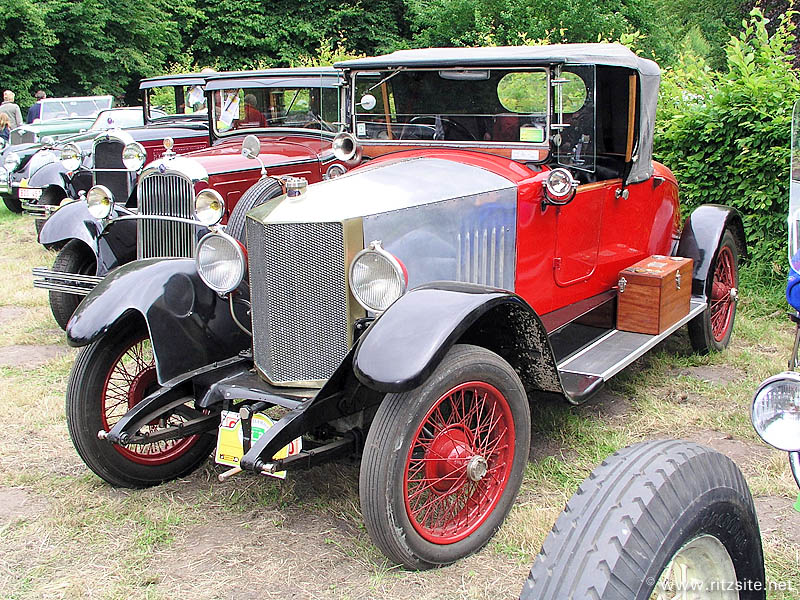|

Métallurgique 12/14 HP - sports roadster body - manufactured in 1921
In the early days of motoring the small Western-European country Belgium played a remarkably important part. Soon after the successful introduction of automobiles in neighboring countries Germany and France a lively and varied automotive industry emerged. On one hand Belgium had almost ideal conditions for building cars: having an important and large ore-processing industry, a big international harbour and an engineering heritage sparked by French and German influence meant that all the basics were at hand for producing cars. On the other however there was also a major drawback: a virtually non-existent home market. This resulted in that most of the produced cars had to be exported to be sold, and with close-by countries not really interested this often meant shipping the cars over to Great Britain or even the USA. Ultimately this lead to the demise of local Belgian car production, but not before some decades of manufacturing interesting cars, usually of high quality.
Though undeserved obscured by time, Métallurgique was once one of the great Belgian marques, together with the likes of Minerva, Imperia, Excelsior, Nagant and FN. The origins of the company were, as its name indicates, in metal working; in producing all sorts of rolling railway equipment to be precise and as such they made quite a name for them selves. Looking to expand on that Métallurgique presented its first prototype cars in 1898. The reception was encouraging and so they continued the development and constructed a new factory for car production. It was opened in 1900 and a year later the first production cars were presented at the Paris Motor Show. These first models were 2-cylinder cars resembling the German Daimlers of that period, but soon after a 4-cylinder model was introduced and 4-cylinder engines were to become the specialty of Métallurgique. Mercedes engineer Ernst Lehmann joined Métallurgique in 1903 and he was responsible for a new range of advanced cars produced by Métallurgique featuring pressed-steel chassis, swing axles, high-tension ignition and optional electric lighting dynamo; all very novel in an era cars mostly resembled horseless carriages. All this combined with a high level of built quality established Métallurgique as a top class car manufacturer.
In the years that followed Métallurgique was most noted for producing fast cars with large 4-cylinder engines, like the 60/80 HP 10 litre model of 1906 and the later 38/90 HP which both offered top speeds exceeding 100 kph and were fairly competitive in racing on the European continent and in Great Britain. In 1909 Métallurgique's best known model appeared: the luxurious 26/60 HP model, a 4-cylinder displacing 5 litres. Most of these cars were sold in Great Britain and fitted with Vanden Plas (also of Belgian heritage) bodywork, often in sporting style and always fitted with the distinctive V-ed radiator shell, Métallurgique's trademark since 1907. Though initially shipped to England these cars ended up all over the British Empire and were even found as far away as New Zealand. In 1912 a special sport version of the 26/60 engine became available, fitted with larger valves and alloy pistons and good for 75 hp.
After the first World War Métallurgique was able to pick up production rapidly thanks to cunningly hiding their jigs and spares during the War. The 26/60 was again on offer, now with four wheel brakes, along with a 15/20 HP and a 20/40 HP model. By now however selling the big cars became more and more difficult as a result of the economic problems resulting from the War. In one last bid for survival Métallurgique replaced their smallest model, the 15/20 HP, in the early 1920s by the innovative 12 HP. It was powered by a 1882 cc 4-cylinder designed by Paul Bastien, who later went on designing 8-cylinder engines for Stutz in the USA. Remarkable about this engine was its over head valve system operated by pushrods, these days very common but back in the days of side- and sleeve valves a leap forward. It was a rapid car, capable of about 121 kph, that handled well but sold not enough to keep Métallurgique's car production out of harms way.
The inevitable end of the cars named Métallurgique came in 1927 when the car manufacturing facilities were sold to Imperia-Excelsior, who moved the tooling over to their own factory and sold the remaining buildings to Minerva. By 1929 the Métallurgique name had disappeared from cars completely. It was an undignified end to a manufacturer that went its own way, was often ahead of its time and firmly believed in the qualities of the 4-cylinder concept. Métallurgique was absorbed into the history books claiming a well-built 4-cylinder could be just as smooth as a 6-cylinder and was more efficient, which was proven correct (in Europe at least) about 50 years later...
These days Métallurgique cars are quite rare but those that remain are spread around the world. Best chances to see one are in Belgium and Great Britain. Luckily there are people which preserve these almost forgotten cars from a long gone era to remind us of a much more colorful automotive past.
© André Ritzinger, Amsterdam, Holland
|
